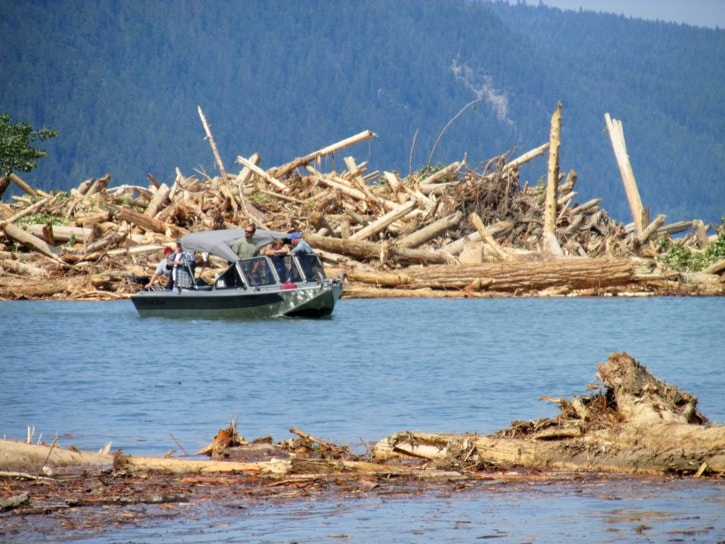As events continue to unravel at the Mt. Polley mine, the scale of the disaster is only beginning to be felt. Not only is drinking water under siege, but so too are salmon runs, tourism, and people’s livelihoods.
Located above the community of Likely, B.C., Mount Polley is an open pit copper/gold mine with a developing underground project.
The breach of the tailings pond sent five million cubic metres of toxic waste into Hazeltine Creek, Quesnel Lake and Polley Lake, with fears it could spread far and wide in the coming days.
The sheer volume of toxic slurry from the pond – equivalent to 2,000 Olympic-sized swimming pools – caused Hazeltine Creek to expand from four feet in width to 150, and some of the sludge has already made its way into Quesnel Lake and Polley Lake.
First Nations and residents are outraged over the incident, blasting the company and the government for not having done enough to prevent the spill in the first place.
Concerns raised in a report three years before were “basically ignored,” said a First Nations leader whose territory has been soiled by the disaster.
Bev Sellers, chief of the Xatsull First Nation, also known as the Soda Creek Indian Band, said many members of her band were in tears when they learned of last Monday’s release of a slurry of contaminated water and mine waste into several local waterways.
“Because they know the destruction that’s going to happen from this breach. It’s just a real sad day,” she said last week.
The company which operates the mine, Imperial Metals Corporation, issued a statement on its website saying “The cause of the breach is unknown at this time…..monitoring instruments and onsite personnel had no indication of an impending breach.”
However, the company had been warned five times in the past about the state of its tailings pond, with the latest warning coming just this past May, this time for exceeding the permitted height of wastewater.
The Ministry of the Environment said the company has applied for two permit amendments in recent years to allow the mine to discharge an increasing amount of wastewater. The first of these prompted an independent report in 2009, in which the company was found to have exceeded allowable levels in the tailings pond.
And in August 2012, the ministry found the mine failed to report the excessive height of wastewater for the perimeter pond. The perimeter pond overflowed, releasing approximately 150 cubic metres of wastewater over 13 hours to ground.
Brian Olding, the environmental consultant who carried out the 2009 assessment for the company and local First Nations groups, says the pond levels were already getting too high five years ago.
“It means the water is rising so you have to build the walls of the tailings lagoon higher as you go,” Olding said.
Olding’s report also criticized the company for not having a contingency plan in case of a tailings pond failure.
Despite the drinking water ban and locally declared state of emergency, company president Brian Kynoch insisted the water quality is good, even saying he would drink it.
“It’s very close to drinking water quality, the water in our tailings,” he said. “There’s almost everything in it but at low levels.... No mercury, very low arsenic and very low other metals.”
The first tests revealed by the provincial government appear to back up Kynoch’s statement. The ministry revealed preliminary test results that state that the water in Quesnel River ‘meet provincial and federal drinking water guidelines.’
However, local First Nations are reporting that skin is peeling away from salmon caught soon after the disaster.
“What happened is when you catch a salmon, you take a newspaper and you wipe the slime off so it keeps it from sliding off the board when you're splitting it open,” Chief Michael LeBourdais of the Whispering Pines/Clinton Indian Bandtold The Huffington Post B.C. in an interview. “When they went to wipe it with the newspaper, the skin came off.”
The longtime fisherman and rancher said, “I've been doing this my whole life, that's never happened before, that you can literally wipe the skin off with your hand.”
The DFO halted salmon fishing in the Cariboo and Quesnel Rivers starting last Tuesday night and several First Nations near Lillooet issued notices to their members to stop fishing last Thursday.
Last week the government approved the controversial controlled release of the rest of the mine wastewater that had flooded into Polley Lake. The release is now underway and the water is being discharged into Hazletine Creek, which has angered many residents and First Nations who feel the environment has suffered enough.
Imperial Metals has committed to ‘cleaning up’ the spill, which is estimated to cost more than $200 million.
